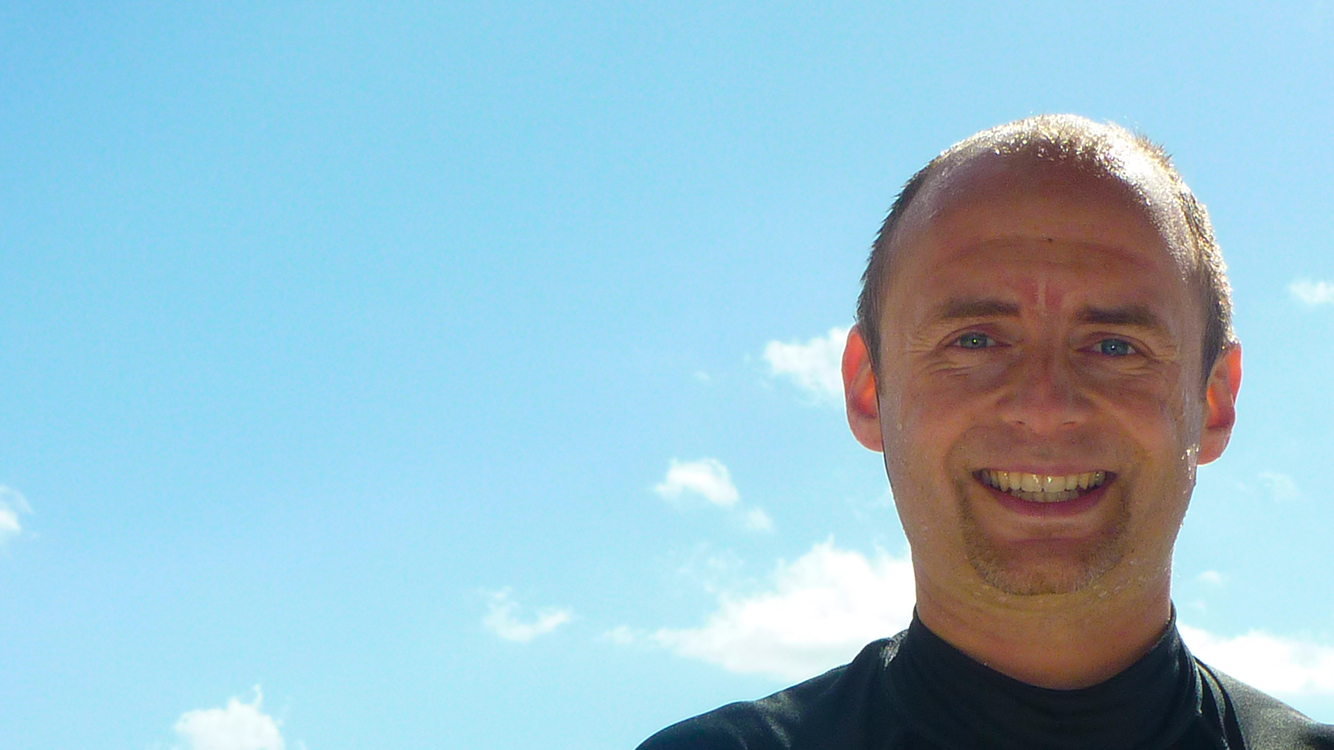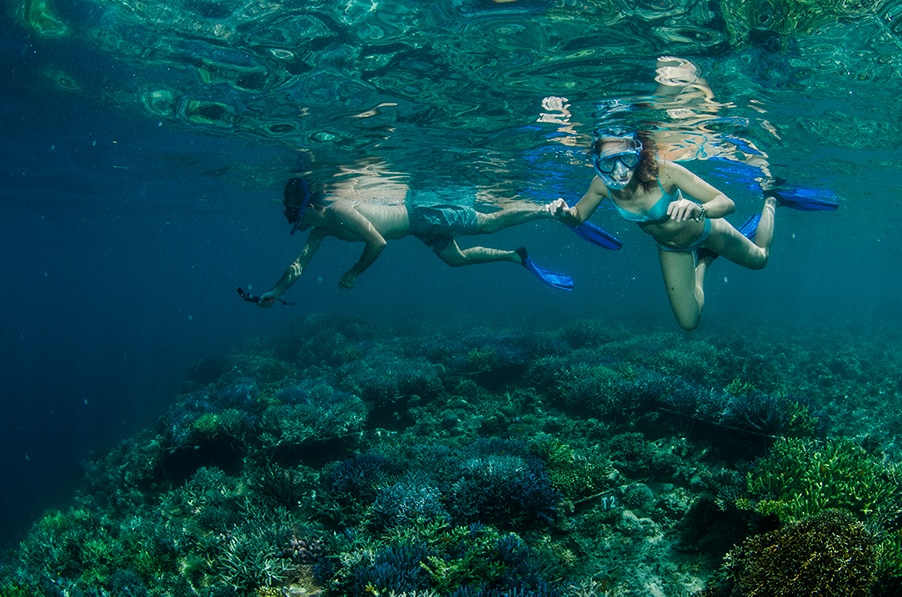The impact of organic UV filters in sunscreens on coral reefs

Sunscreens contain many components, including various UV filters that can be organic (chemical) or inorganic (mineral). Scientists are becoming increasingly interested in their effects on marine life, once these substances leave the skin and end up in seawater.
Organic or chemical UV filters are derived from petrochemicals. Among those that have been studied by researchers to date are: oxybenzone (BP-3), octocrylene (OC), ethylhexyl salicylate (ES), homosalate (HMS), octisalate (OS), ODPADA, ethylhexyl methoxycinnamate (octinoxate or EHMC), and other benzophenone type compounds (BP-1, BP-4, BP-8).
Many of these compounds accumulate in coral tissue. In laboratory experiments, this bioaccumulation has been shown to be greater when exposed to the whole sunscreen compared to the component alone (He et al, 2019).
Oxybenzone (BP-3) and octocrylene (OC) have been the subject of several recent studies.
In 2019, Wijgerde et al. tested the effect of oxybenzone and temperature increase on two species of hard corals (Acropora tenuis and Stylophora pistillata).
It appears that exposure to oxybenzone, combined with heat stress, accelerates the mortality of the coral colonies tested. A reduction in the photosynthetic yield of the associated microalgae and a disturbance of the microbiome of one of the tested species was observed (alteration of the abundance of several bacterial families). In addition, the concentration of oxybenzone tested (~ 0.06 μg/L) is relevant to that measured in situ in Bonaire in 2018.
Oxybenzone is photo-toxic, i.e. the undesirable effects are exacerbated by light.
In the Downs study in 2016, exposure to oxybenzone induced ossification of the planulae (mobile larvae of corals, anemones and other cnidarians, resulting from sexual reproduction) of the test species (Stylophora pistillata), enclosing the entire planula in its own skeleton. This compound is a skeletal endocrine disruptor, so it unbalances the regulation of skeletal production. The concentration of oxybenzone inducing a negative effect on these planulae and the toxicity induced on the coral cells of 7 other coral species tested, are consistent with those measured at sites frequented by bathers in Hawaii and the US Virgin Islands.
Oxybenzone toxicity was also shown in another hard coral species (Pocillopora damicornis) where a stress response was observed after exposure to a concentration of 2mg/L (Stien et al, 2020). This high concentration was also measured in the field.
These studies have shown that sensitivity to oxybenzone varies between coral species.
Researcher Stien has also tested the effect of octocrylene (OC) on the scleractinian Pocillopora damicornis on several occasions: a negative impact appears as soon as the concentration reaches 50 μg/L. OC is thought to cause mitochondrial dysfunction (the mitochondrion is an organelle of cells in charge of energy production). This component appears more toxic than oxybenzone.
In his 2020 study, he showed that ethylhexyl salicylate (ES) also causes a stress response from 50 μg/L, which would also make this compound more toxic than oxybenzone.
As far as other organic UV filters are concerned, there is still very little data on their effects or their concentration in situ. The latter show significant spatial and temporal variations (Tsui et al., 2014).
However, ethylhexyl methoxycinnamate (EHMC) is thought to present a high risk of bleaching hard corals. Some benzophenones such as BP-1 and BP-8 show higher toxicities than oxybenzone (BP-3). As in the studies by Downs et al (2014, 2016), some benzophenones could cause oxidative stress in corals or zooxanthellae, leading to bleaching (He et al, 2019).
In the laboratory, these compound exposure experiments are carried out on a relatively short time scale (from a few days to a few weeks). It would be interesting to be able to test long-term effects. As with the actual concentrations remaining in seawater surrounding coral reefs, more research is needed to make an accurate statement on the effect of sunscreen use when swimming near coral reefs.
✍️ Solène Ollivier
📸 Hannah Prewitt
For more information:
Downs C.A., 2016. Toxicopathological Effects of the Sunscreen UV Filter, Oxybenzone (Benzophenone-3), on Coral Planulae and Cultured Primary Cells and Its Environmental Contamination in Hawaii and the U.S. Virgin Islands. Arch Environ Contam Toxicol 70 (2), pp. 265–288. DOI: 10.1007/s00244-015-0227-7
He T. et al., 2019. Comparative toxicities of four benzophenone ultraviolet filters to two life stages of two coral species. Science of the Total Environment Feb 15;651(Pt 2), pp. 2391-2399 DOI: 10.1016/j.scitotenv.2018.10.148.
Stien D. et al., 2018. Metabolomics reveal that octocrylene accumulates in Pocillopora damicornis tissues as fatty acid conjugates and triggers coral cell mitochondrial dysfunction. Anal. Chem., 91 (1), pp. 990-995. DOI: 10.1021/acs.analchem.8b04187
Stien D. et al., 2020. A unique approach to monitor stress in coral exposed to emerging pollutants. Scientific Reports 10, 9601 | https://doi.org/10.1038/s41598-020-66117-3
Tsui et al, 2014. Occurrence, distribution and ecological risk assessment of multiple classes of UV filters in surface waters from different countries. Water Research 67 (15), 55-65. https://doi.org/10.1016/j.watres.2014.09.013
Wijgerde T. et al, 2019. Adding insult to injury: Effects of chronic oxybenzone exposure and elevated temperature on two reef-building corals. Science of The Total Environment 773, 139030. DOI: https://doi.org/10.1101/2019.12.19.882332
Ces articles pourraient vous intéresser

Sponsor spotlight : Alban from W2P
Tell us a bit about yourself 🙂 I am Alban Taravello, producer and founder of W2P Production. I am passionate about diving, deep-sea observation and video….
21 March 2023
Sponsor spotlight : Fabrice from RedSea
Tell us a bit about yourself 🙂 Fabrice Bonnaventure, unfortunately already in my fifties, married, two children. I got into the hobby of aquarium keeping…
21 October 2022
Overall, what is the impact of UV filters in sunscreens on corals?
Around the world, coral reefs are facing a degradation driven by global and local human-derived pressures including climate change, coastal development, pollution, amongst others. In…
31 March 2021
